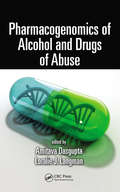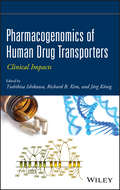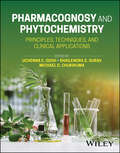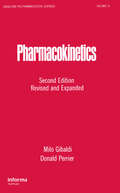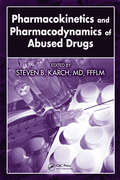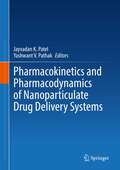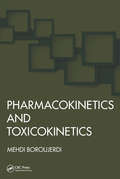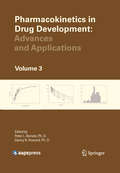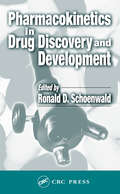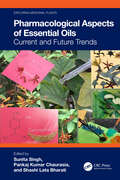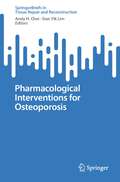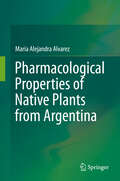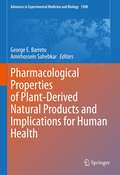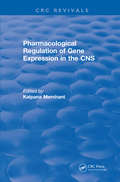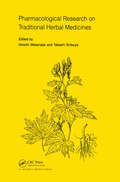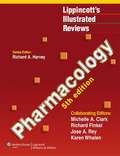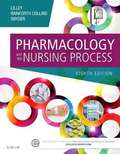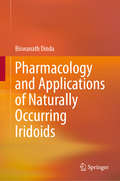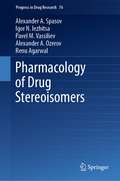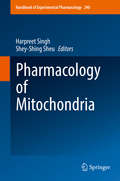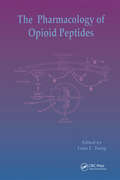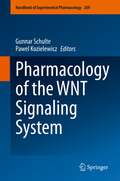- Table View
- List View
Pharmacogenomics in Drug Discovery and Development (Methods in Molecular Biology #2547)
by Qing YanThis new edition offers a state-of-the-art and integrative vision of pharmacogenomics by exploring new concepts and practical methodologies focusing on disease treatments, from cancers to cardiovascular and neurodegenerative disorders and more. The collection of these theoretical and experimental approaches facilitates problem-solving by tackling the complexity of personalized drug discovery and development. Written by leading experts in their fields for the highly successful Methods in Molecular Biology series, the book aims to provide across-the-board resources to support the translation of pharmacogenomics into better individualized health care. Authoritative and up-to-date, Pharmacogenomics in Drug Discovery and Development, Third Edition aims to aid researchers in approaching the challenges in pharmacogenomics and personalized medicine with the introduction of these novel ideas and cutting-edge methodologies.
Pharmacogenomics of Alcohol and Drugs of Abuse
by Amitava Dasgupta Loralie J. LangmanPharmacogenomics is the basis of personalized medicine, which is said to be the medicine of the future. Understanding genetic variation in drug and alcohol response is vital for professionals working in rehabilitation programs. The same principles that are applicable for therapeutic drugs are also applicable for drugs of abuse. Pharmacogenomics can
Pharmacogenomics of Human Drug Transporters: Clinical Impacts
by Richard B. Kim Toshihisa Ishikawa Jörg KönigSets the foundation for safer, more effective drug therapies With this book as their guide, readers will discover how to apply our current understanding of the pharmacogenomics of drug transporters to advance their own drug discovery and development efforts. In particular, the book explains how new findings in the field now enable researchers to more accurately predict drug interactions and adverse drug reactions. Moreover, it sets the foundation for the development of drug therapies that are tailored to an individual patient's genetics. Pharmacogenomics of Human Drug Transporters serves as a comprehensive guide to how transporters regulate the absorption, distribution, and elimination of drugs in the body as well as how an individual's genome affects those processes. The book's eighteen chapters have been authored by a team of leading pioneers in the field. Based on their own laboratory and clinical experience as well as a thorough review of the literature, these authors explore all facets of drug transporter pharmacogenomics, including: Individual drug transporters and transporter families and their clinical significance Principles of altered drug transport in drug–drug interactions, pharmacotherapy, and personalized medicine Emerging new technologies for rapid detection of genetic polymorphisms Clinical aspects of genetic polymorphisms in major drug transporter genes Future research directions of drug transporter pharmacogenomics and the prospect of individualized medicine Pharmacogenomics of Human Drug Transporters opens the door to new drug discovery and development breakthroughs leading to safer and more effective customized drug therapies.The book is recommended for pharmaceutical scientists, biochemists, pharmacologists, clinicians, and genetics and genomics researchers.
Pharmacognosy and Phytochemistry: Principles, Techniques, and Clinical Applications
by Shailendra S. Gurav Uchenna E. Odoh Michael O. ChukwumaKey information on plant-based chemical and pharmacology research, from basics and principles through recent technological advances Pharmacognosy and Phytochemistry provides an overview of the basics of pharmacognosy and phytochemistry from early principles through contemporary advances like molecular pharmacognosy. The book covers the classification of crude drugs, complementary and alternative medical (CAM) systems, adulteration and evaluation of drugs, extraction methods of plant drugs, and ethnobotany and ethnopharmacology. The book also reviews the historical overview, therapeutic application, cultural and ecological dimensions of plant-based medicines. Other key chapters discuss biotechnology and clinical pharmacognosy. Written by a group of expert contributors, Pharmacognosy and Phytochemistry reviews sample topics including: Methodologies for extracting bioactive compounds and techniques to perform qualitative and quantitative phytochemical analysisTherapeutic potential of plant secondary metabolites and the processes of isolation, purification, and characterization of herbal drugsBiological screening methods and biosynthetic pathways of phytopharmaceuticals, pharmaceutical aids, nutraceuticals, cosmeceuticals, pesticides, and allergensComparative phytochemistry, chemotaxonomy, and the emerging field of marine pharmacognosy Combining traditional knowledge with modern advancements to provide a holistic understanding of two important fields, Pharmacognosy and Phytochemistry serves as an excellent resource for students, researchers, and practitioners.
Pharmacokinetics (Drugs and the Pharmaceutical Sciences)
by Milo Gibaldi Donald PerrierThis book is based on research papers and commentaries on pharmacokinetic methods and applications published since 1975. It offers detailed examinations of new developments in the pharmacokinetic field with enhanced clarity of presentation and simplified organization.
Pharmacokinetics and Pharmacodynamics of Abused Drugs
by Steven B. KarchThis book is a concise and focused volume on the metabolism and measurable effects of drugs on the human body. Beginning with basic concepts and models, the book details the specifics of absorption, distribution, and elimination mechanisms and rates of commonly abused drugs. It analyzes the effects of drug use on human performance including response time, memory and cognition, and physiological changes. Packed with data and comparative studies, this handy volume considers the effects of marketed and prescription medications as well as illicit drugs. Containing 29 figures and tables and extensive references, this is a must-have resource for the influence of drug use and abuse on human physiology and performance.
Pharmacokinetics and Pharmacodynamics of Nanoparticulate Drug Delivery Systems
by Jayvadan K. Patel Yashwant V. PathakA reference is needed that addresses the recent progress in aspects of PK/PD methods and developments of nanoparticles for novel drug delivery systems. No other consolidated published reference discusses the PK/PD study of nanoparticle drug delivery systems. This book discusses the advantages of nanoparticle drug delivery systems (NPDDS) in enhancing the pharmacokinetics of many drugs that are not easily metabolized or that obtain the desired therapeutic effect with minimum toxicity. The authors provide an overview of biodistribution with a focus on polymer and lipid nanoparticles. This thorough reference is divided into three parts: Modelling, Specific carries and their potential to treat specific diseases.
Pharmacokinetics and Pharmacodynamics of Novel Drug Delivery Systems: A Machine-Generated Literature Overview
by Sankalp A. Gharat Munira M. Momin Tabassum KhanThe book delves into the intricate realm of pharmacokinetics and pharmacodynamics as they apply to modern advancements in drug delivery systems. It offers a comprehensive exploration of novel drug delivery methods, with a particular focus on nanoparticles and nanocarriers. The absorption, distribution, metabolism, and excretion processes of nanoparticles are extensively examined. It also covers various evaluation models, spanning from preclinical to clinical, aimed at assessing the effectiveness and safety of nanoparticles in drug delivery. It also covers the integration of Artificial Intelligence and Machine Learning in pharmacokinetics and pharmacodynamics, showcasing how these cutting-edge approaches can enhance our understanding of drug behavior and optimize therapeutic outcomes. It serves as a comprehensive guide, highlighting the fusion of traditional pharmacological concepts with contemporary drug delivery systems and innovative technologies, all in the pursuit of refining medical treatments and patient care and is a valuable resource for academicians, researchers, and pharmacologists.
Pharmacokinetics and Toxicokinetics
by Mehdi BoroujerdiPharmacokinetics and Toxicokinetics provides an overview of pharmacokinetics and toxicokinetics in a comprehensible, interrelated, and applied manner. It integrates the principles held in common by both fields through a logical and systematic approach. The book presents mathematical descriptions of physiological processes employed in different appr
Pharmacokinetics in Drug Development
by Peter L. Bonate Danny R. HowardThe topics chosen for this volume were selected because they are some of the current development or technological issues facing drug development project teams. They regard the practical considerations for assessment of selected special development populations. For example, they include characterization of drug disposition in pregnant subjects, for measuring arrhythmic potential, for analysis tumor growth modeling, and for disease progression modeling. Practical considerations for metabolite safety testing, transporter assessments, Phase 0 testing, and development and execution of drug interaction programs reflect current regulatory topics meant to address enhancement of both safety assessment and early decision-making during new candidate selection. Important technologies like whole body autoradiography, digital imaging and dried blood spot sample collection methods are introduced, as both have begun to take a more visible role in pharmacokinetic departments throughout the industry.
Pharmacokinetics in Drug Discovery and Development
by Ronald D. SchoenwaldPharmacokinetics has evolved from its origin into a complex discipline with numerous subspecialties and applications in patient management, drug development, and regulatory issues. This expansion has made it difficult for any one individual to become a full-fledged expert in all areas. Fulfilling the need for a wide-ranging guide to the many existi
Pharmacological Aspects of Essential Oils: Current and Future Trends (Exploring Medicinal Plants)
by Sunita Singh Pankaj Kumar Chaurasia Shashi Lata BharatiPharmacological Aspects of Essential Oils: Current and Future Trends provides a collection of therapeutic and pharmacological applications of the most researched essential oils of great importance derived from Clove, Cinnamon, Coriander, Turmeric, Thymus zygis, Thyme vulgaris, Ocimum basilicum, Copaifera spp, and Nigella sativa species. The new approach towards using a metal phenolic network with the essential oils as a tool of nanomedicine will surely open a new horizon for the research community. Treating disorders such as diabetes, insomnia, and obesity with essential oils will provide a new area of research. Aromatherapy, which is creating a market especially in the personal health care sector, is also discussed in the book. The relation between chemical composition and different biological properties is well discussed in respective chapters. The other practical topics related to the development of this industry of essential oils have been illustrated with elaborative figures and tables. Providing such updated data on the pharmacological applications of essential oils is an asset to the community associated with the extraction and production of essential oils, biochemist, aromatherapist, agrotechnologists, and nutritionist fraternities. Salient Features: Metal phenolic networks and essential oils as tool of nanomedicine Role of essential oils in aromatherapy Sophisticated development of various advanced techniques in the characterization of essential oils Pharmacological applications of Brazilian aromatic species Role of essential oils in management of diabetes, obesity, and insomnia
Pharmacological Interventions for Osteoporosis (Tissue Repair and Reconstruction)
by Andy H. Choi Sian Yik LimThis book provides readers a fundamental insight into the basic properties of the pharmaceutical agents used in the treatment of osteoporosis. It provides insight into mechanisms of action, updated information on clinical utility, and possible side effects associated with the use of these pharmaceutical agents. In particular, it highlights the use of two monoclonal antibodies romosozumab and denosumab in activating osteoblast differentiation and inhibiting osteoclasts. It also discusses two anabolic pharmaceutical agents, teriparatide and abaloparatide to treat osteoporosis. They have been shown to reduce the incidence of non-vertebral and vertebral fractures significantly after they were administered to patients daily as subcutaneous injections. The content of this book caters to researchers, scientists, and clinical practitioners who are interested in the treatment of osteoporosis using pharmaceutical agents.
Pharmacological Properties of Native Plants from Argentina
by María Alejandra AlvarezThe aim of this book is to offer information about the Pharmacological Properties of Native Plants from Argentina to students, researchers and graduates interested in the fields of Ethnobotany, Pharmacognosy, Phytochemistry, Pharmacy, and Medicine. The book includes summary information about the native plants from Argentina with medical activity comprising their botanical characteristics, distribution, characteristics of the regions where they grow, ethnobotanical information, chemical data, biological activity, establishment of in vitro cultures, toxicity, and legal status.
Pharmacological Properties of Plant-Derived Natural Products and Implications for Human Health (Advances in Experimental Medicine and Biology #1308)
by George E. Barreto Amirhossein SahebkarMedicinal plants and their derived products remain as an indispensable source of bioactive molecules that serve as either drug candidates or lead compounds for drug design and discovery. There are several advantages for plant-derived therapeutics including wide availability, diverse pharmacological actions and a generally good profile of safety and tolerability. Over the recent years, there have been numerous reports from clinical studies testifying to the efficacy and safety of medicinal plants and phytochemicals in ameliorating several human diseases. A plethora of basic studies has also unravelled molecular mechanisms underlying the health benefits of herbal medicines. Nevertheless, issues such as identification of bioactive ingredients, standardization of the products and drug interactions remain to be further studied. In this book, we aim to put together several chapters on the medicinal properties and pharmacological action of medicinal plants, plant species and phytochemicals. The goal is to present a comprehensive collection on most of the therapeutic aspects of plant-derived natural products and molecular mechanisms thereof.
Pharmacological Regulation of Gene Expression in the CNS Towards an Understanding of Basal Ganglial Functions (CRC Press Revivals)
by Kalpana MerchantThis book focuses on dopamine-mediated regulation of gene expression within the striatum and associated regions of the central nervous system. It is an excellent review of experimental data on interactions between neuronal systems at systemic, cellular, and molecular levels. Each of the chapters, written by the world's leading scientists, provides an understanding of anatomy, neurochemistry, and cellular and molecular effects. Such an understanding sheds light on the pathophysiology of central disorders involving the basal ganglia and leads to new approaches for the treatment of diseases such as Parkinson's disease and schizophrenia, and also addictions to psychostimulants such as cocaine and amphetamines.
Pharmacological Research on Traditional Herbal Medicines
by Hiroshi WantanabeA concise overview of some of the findings and topics related to the pharmacology and clinical applications of traditional herbal therapeutics. It addresses the current and potential roles for herbal medicine in the context of our evolving health-care systems. Introducing many pharmacological advances made, the work also describes the modern theories and scientific methodologies applied to today's studies on herbal medicines and new drug development.
Pharmacology
by Richard A. Harvey Michelle A. Clark Richard Finkel Jose A. Rey Karen WhalenLippincott's Illustrated Reviews: Pharmacology, Fifth Edition enables rapid review and assimilation of complex information and focuses on the essentials of medical pharmacology. Clear, sequential pictures present mechanisms of action and actually show, rather than tell, students how drugs work. This book features a signature outline format with more than 500 full-color illustrations and cross-references to other volumes in this bestselling, student-oriented series.
Pharmacology And The Nursing Process
by Linda Lane Lilley Shelly Rainforth Collins Julie S. SnyderLet this outstanding pharmacology text help you learn how to administer drugs safely and effectively! Now in its eighth edition, Pharmacology and the Nursing Process continues to deliver the perfect amount of pharmacology, prioritization, and nursing process information to today''s nursing students. Centering on its unique key drug approach, this text focuses only on the drug information you need to safely administer drugs. The text also continues to emphasize the nursing process and prioritization, covering the most essential assessments, nursing diagnoses, interventions, and evaluations you need to practice effectively. New to this edition is even more coverage of QSEN competencies, simpler language, and a wealth of reader-friendly features and innovative learning aids. Along with its integrated NCLEX preparation and insightful learning strategies, you won''t find a more complete pharmacology text on the market!
Pharmacology and Applications of Naturally Occurring Iridoids
by Biswanath DindaIn this book, the author provides expert analysis on naturally occurring iridoids, their chemistry and their distribution in plants and insects. Particular attention is given to the pharmacology of iridoids and their prospective applications in pharmaceutical and agricultural industries. Iridoids are found in a wide variety of plants and some insects, and they are structurally derived from monoterpenoid natural products. In the first two chapters of this book, the author describes the iridoids classification, occurrence and distribution in plants and insects. The following chapters cover different chromatographic and spectroscopic techniques that can be used to identify and quantify iridoids in herbal formulations, and also the biosynthesis of iridoids, in which the reader will discover a metabolomics and transcriptomics analysis to identify the genes involved in the biosynthesis. The final chapters provide insights on several pharmacological activities of iridoids, their physiological role in insects, pharmacokinetics in mammals, insects and microorganisms, and their applications in medicine and agriculture. This book will engage students and researchers interested in the chemistry of natural products, and it will also appeal to medicinal chemists and practitioners working in the design of new herbal drugs with bioactive pure iridoids.
Pharmacology of Bombax ceiba Linn.
by Vartika Jain Surendra K. VermaThis work is the first monograph devoted solely to Bombax ceiba, popularly known as the Red Silk Cotton Tree. Consisting of seven chapters, it covers all relevant aspects of this plant, from its historical and spiritual importance, to its botanical characterization, pharmacognostical details and ethnobiological uses, to its scientific validation in various animal and human studies. Each part of the tree is of medicinal value and possesses many novel chemical constituents such as shamimicin, bombasin, bombamalone, bombamaloside etc. along with other bioactive secondary metabolites. The book presents the chemical structures of the most important constituents and highlights various pharmacological activities, predominantly antioxidant, anti-inflammatory, anti-mutagenic, hypoglycemic, hypotensive, hepatoprotective and fibrinolytic, which may prove to be a source for the development of a novel phyto-pharmaceutical agent to treat diabetes, heart disease and cancer. In addition, separate chapters deal with the commercial and ecological significance of B. ceiba, as well as a case study on its conservation. Numerous color illustrations are included to identify the plant and to justify its nickname, the "Little Bird's Cafeteria".
Pharmacology of Drug Stereoisomers (Progress in Drug Research #76)
by Renu Agarwal Alexander A. Spasov Igor N. Iezhitsa Pavel M. Vassiliev Alexander A. OzerovThe book is devoted to an important aspect of pharmacology and pharmaceutical chemistry, i.e. the significance of stereoisomerism of drugs for their biological effect from the point of view of their pharmacokinetics, pharmacodynamics and toxicology. The authors review the landmarks in the development of stereochemistry and stereopharmacology. Present-day IUPAC terminology is discussed; general issues of stereoisomerism are considered including separation of racemic mixtures and asymmetric synthesis of isomers, methods of quantifying the isomers of a drug in biological material. The authors put special emphasis on general problems of the influence of stereoisomerism on pharmacological and adverse effects of drugs. A classification of drugs based on stereochemical properties of their isomers is proposed. Possibilities of interaction of stereoisomers in racemic mixtures are discussed. A considerable portion of the book is devoted to pharmacological action of the main groups of drugs whose structure includes asymmetric atoms (that is, drugs with several isomers). Detailed attention is paid to advisability of developing single isomer drugs and to the specifics of their study at the stage of preclinical and clinical trials.
Pharmacology of Mitochondria
by Harpreet Singh Shey-Shing SheuThis special book is conceived to highlight mitochondrial structural and functional integrity and how they are associated with several human diseases such as cardiovascular, cancer, renal, neurological disorder, and genetic disorders. The chapters contributed by leading mitochondrial researchers in the handbook will take us through the novel pharmacological strategies via mitochondria to understand their physiological and pathological role as well as present them as therapeutic targets.
Pharmacology of Opioid Peptides
by Leon F. TsengThis book is being published at a time when opioid receptors have recently been cloned. The structural characteristics of opioid receptors and the recent advances in their molecular cloning and expression are explicated. Connecting these cloned opioid receptors with the pharmacology of opioid receptor actions is of particular importance. The use of
Pharmacology of the WNT Signaling System (Handbook of Experimental Pharmacology #269)
by Gunnar Schulte Pawel KozielewiczThis book reflects the state of the art of our understanding of the WNT signaling system, which comprises a network of signaling pathways initiated by the secreted WNT lipoglycoproteins, which are crucial for embryonal development, stem cell regulation, tissue homeostasis and repair. Dysfunction of this evolutionarily conserved signaling system leads to many diseases including developmental disorders, diverse forms of cancer, fibrosis, neurodegenerative disease and many more. The WNT signaling system is built upon 19 mammalian, secreted WNT lipoglycoproteins that interact with a plethora of distinct receptors, such as the G protein-coupled receptors called Frizzleds (FZD1-10), LDL receptor-like proteins (LRP5/6), receptor tyrosine kinases (ROR1, 2, RYK and PTK7). In addition, WNT pathways are tightly regulated by many secreted and cell-intrinsic negative regulators, such as soluble FZD-related proteins (SFRPs), Dickkopfs (DKKs), WNT-inhibitory proteins, TIKI, RNF43 and more. Understanding the basic mechanism in terms of receptor-ligand interaction, receptor selectivity, signal initiation and desensitization remain poorly understood, even though substantial advances have been made the recent years. Due to the involvement of the WNT signaling system in human disease, it appears obvious to target diverse branches pharmacologically and therapeutically. However, given the complexity of the system and its importance for stem cell regulation and tissue maintenance, therapy comes with obvious risks for severe side effects. The field is addressing the challenge to identify suitable targets and selective compounds for therapy allowing disease-selective therapeutic effects and balancing unwanted side effects. This book summarizes the current understanding of the basic and applied pharmacology in the WNT signaling system and bridges disciplines such as pharmacology, physiology, neurosciences, oncology and drug development.

